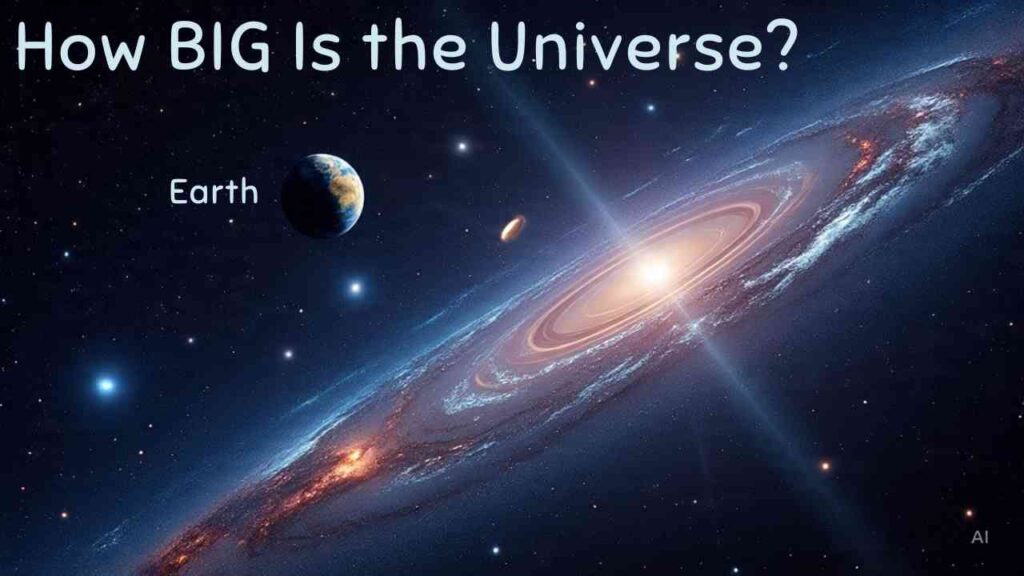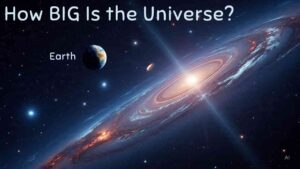
Introduction: A Universe Beyond our Grasp
If you have ever looked up at the night sky and felt insignificant, you are not alone. For centuries, humans have questioned the size of the universe. And the further science explores, the more mind-bending the results are. how big is the universe — it is larger than anything that we can even imagine.
In this article, we’ll take a step-by-step journey through space — starting from Earth and zooming out to the edge of the observable universe. We’ll explore what lies beyond, how astronomers measure such distances, and what this all means for our place in the cosmos.
Earth how big in the universe: A Tiny Dot in Space
Let’s start with our home world, Earth. It’s approximately 12,742 kilometers in diameter and circles the Sun at an average distance of 150 million kilometers (1 Astronomical Unit or AU).
To us, Earth appears massive. But comparatively, it’s almost insignificant. It’s just one planet of eight in our solar system, which is itself just one of billions in the galaxy.
The Sun and the Solar System: Our Immediate Neighborhood
The Sun is a medium-sized star that is approximately 1.39 million kilometers across — more than 100 times larger than Earth. You could fit roughly 1.3 million Earths within it.
Our solar system has not only planets, but also moons, asteroids, comets, and outer areas such as the Kuiper Belt and the Oort Cloud. The Oort Cloud is thought to stretch almost 100,000 AU from the Sun — that’s almost 15 trillion kilometers.
And despite all this, the solar system is still relatively tiny in comparison to the galaxy it resides in.
The Milky Way Galaxy: A City of Stars
Our galaxy, the Milky Way, is a barred spiral galaxy measuring about 100,000 light-years in width. It has more than 100 to 400 billion stars, each with its own potential planetary system. Our Sun is situated in one of the arms of the galaxy, the Orion Arm, at a distance of about 27,000 light-years from the center of the galaxy.
If the solar system were as big as a coin, the Milky Way would be as large as North America. That’s how tiny we are on the galaxy scale.
Even at the speed of light — almost 300,000 kilometers a second — it would take 100,000 years to travel across our galaxy.
Other Galaxies: Just One of Trillions
For centuries, the Milky Way was thought to be the whole universe by humanity. That all changed in the early 20th century when “spiral nebulae” were found to be other galaxies beyond the Milky Way by astronomers, led primarily by Edwin Hubble.
Now, due to the powerful telescopes of Hubble and James Webb, we’ve estimated that there are more than 2 trillion galaxies in the observable universe. Some galaxies are smaller than the Milky Way; others, such as IC 1101, are more than 6 million light-years in diameter and comprise hundreds of trillions of stars.
Our nearest neighbor galaxy, Andromeda, is roughly 2.5 million light-years away and is headed on a collision course with the Milky Way — due to merge in about 4.5 billion years.
The Observable Universe: 93 Billion Light-Years Across
The observable universe is the part of the whole universe that we can observe — based on how far light has been able to travel since the universe began.
The Big Bang happened approximately 13.8 billion years ago, so it would logically follow that the universe is 13.8 billion light-years across every direction. But because of how space has expanded, what we can observe from the universe is really around 93 billion light-years in diameter.
That’s correct — space itself has been expanding, so light from certain galaxies has been coming toward us for billions of years, but the galaxies themselves are now even further away.
In all this empty space, there are estimated to be:
2+ trillion galaxies
More than 1,000,000,000,000,000,000,000 (1 septillion) stars
An unspecified number of planets, moons, and other objects
What’s Outside the Observable Universe?
This is where science turns to speculation — though highly educated.
The observable universe is limited by the distance light has traveled to us. Beyond that edge could lie an even larger (or even infinite) universe that we’ll never be able to observe, because light from those regions hasn’t reached us — and may never will.
There are theories which say that the universe is infinite, and others which say that it’s finite but unbounded — in other words, space curves back in on itself as with the surface of a sphere.
Then there is the multiverse theory, which indicates that our universe is just one of many — each with its own physics, matter, and potentially life.
How Scientists Measure Distances in Space
You may be wondering how astronomers can measure distances as vast as the ones above. They employ a number of techniques, some of which include:
Parallax: Measuring how close stars appear to move against background stars as our Earth moves around the Sun.
Standard Candles: Employing known brightness of objects such as Cepheid variables or Type Ia supernovae to compute distance.
Redshift: Quantifying how light from galaxies is shifted due to the expansion of space.
These techniques have enabled scientists to chart the universe’s shape with remarkable precision.
What Does This Mean for Mankind?
The enormity of the universe is difficult to comprehend. It can make one’s everyday problems seem insignificant and even lead to questions about existence.
But there’s another side to it.
In this fantastically huge universe, life — and particularly intelligent life — appears to be uncommon. To the best of our knowledge, Earth is the lone home for life.
That makes us not unimportant — but fantastically valuable.
The atoms within your body were created in ancient stars. The fuel that powers your thoughts was once incorporated in exploding suns. You are actually composed of star-stuff — and you’re part of the universe attempting to know itself.
Conclusion: how big is the universe : Larger Than You Can Envision
So just how big is the universe?
Large enough that it cannot be truly comprehended.
Large enough that light — the speediest there is — can’t travel to its outer reaches in more than 13 billion years.
And large enough to remind us of how miraculous our own existence really is.
The next time you gaze up at the stars, keep in mind:
You’re looking back in time.
You’re part of something incredibly, mind-bogglingly big.
And you’re one of the few creatures — perhaps the only one — who can ask,
“How large is the universe actually?”
Read more on Our Space Science Section more informative, researched articles.







